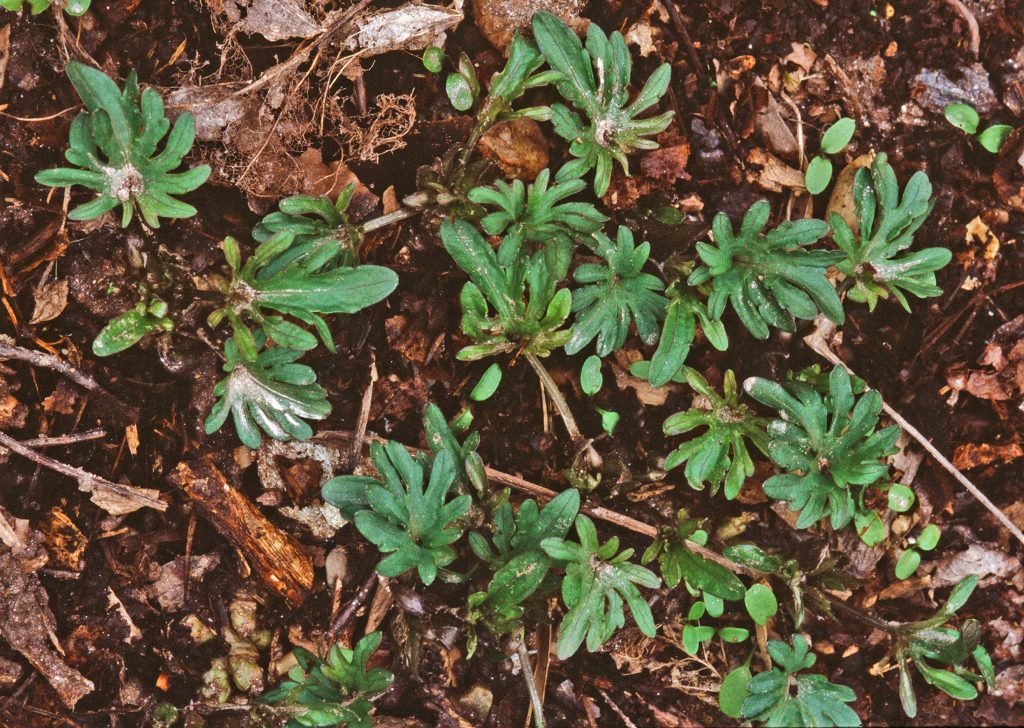Viola xsubsinuata Greene (pro sp.)
Unedited notes on Viola subsinuata; 3 photographs, no drawings
Pittonia 4:4. 1899.
(syn. V. palmata auct. non L., V. pedatifida x sororia)
TM: Section Nosphinium, subsect. Boreali-Americanae [NEW classification, 2010].
Harvey Ballard, July 2005 & Michigan Botanist, 1994: V. xpalmata produces leaves early in the growing season and in the fall that are undivided (cf. V. subsinuta with early spring and late fall leaves are divided). They are both nothotaxa, the product of hybridization in this case between V. sororia and V. sagittata. V. xpalmata grows on moist diabase (low in calcium). [We found a violet in N. Carolina at Penny’s Bend that I thought was a hybrid of V. pedatifida but when growing at home the first leaf the rhizome produced was undivided, so that makes it xpalmata by Harvey’s definition. It was growing on diabase=neutral pH.]

The plants grown from seed given to me by Carol Lim are hybrids between V. pedatifida and V. sororia!!! Are these the only photos I have of a real V. xsubsinuata.
From Pat Carson, Michigan, seeds black, aril clear, 2.3-2.5 x 1.2-1.4 mm.
Harvey Ballard in Michigan Botanist, 1994: Massachusetts west to Minnesota, south to Georgia and Oklahoma.
Morphology is essentially identical to V. xpalmata, except that all leaves are moderately to deeply lobed, the central division lobed like the lateral.
In the Great Lakes region Ballard (1980) found that most sites of well-defined V. pedatifida also harbored de novo hybrids with V. sororia, which grew nearby in mesic forest sites. These hybrids occupied ecotonal [An ecotone is a transition area between two adjacent ecological communities (ecosystems)] and disturbed areas, and were identical with specimens of “V. palmata” from the states further east, where V. pedatifida was not known. Many individuals from southeastern Michigan populations of V. x subsinuata approached V. pedatifida in morphological features and occupied more prairie-like microhabitats within the broader habitat. These observations led me to conclude that V. pedatifida, once native to southeastern Michigan, had been eliminated through succession, being replaced by hybrid derivatives with V. pedatifida genes that provided the plants adaptive advantages to persist in the closed canopy forests. Misled by examinations of (flowering) herbarium specimens alone, both Russell (1965) and Cronquist (1991) interpreted variation in the V. pedatifida-palmata melange simplistically to represent intergradation of V. pedatifida and “V. palmata” in the western Great Lakes region. The latter author involved this inaccurate and sweeping interpretation in his new combination, V. palmata L. var. pedatifida (G. Don) Cronq.

May 5, 2009: With Mike Slater: State Game Lands 56, which has a moist meadow containing a number of interesting plants, including a good-sized population of Aristolochia serpentaria. Photographed V. Xpalmata, and hirsutula flowers, V. adunca minor, V. sororia, also V. Xsubsinuata?? See other notebook. Not diabase here at this location.

Directions: From Doylestown, take PA Route 611 north. At 1.2 miles north of Ottsville, the road forks; take the left branch to get onto Durham Rd/PA-412. Follow this road for 0.5 miles, turn left onto Mountain View Dr/PA-563. After 1.2 miles, turn right onto Top Rock Trail. After 0.6 miles, where the road bends to the right, pull into the parking lot on the left. The lot has no sign visible from the road, but once you are in the lot, you will see a sign saying “Welcome, Hunt Safely.” To get directions from Mapquest or other on-line service, use the address 200 Top Rock Trail, Kintnersville, PA.